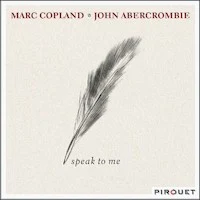Styles: Guitar Jazz
Year: 1989
File: MP3@320K/s
Time: 55:47
Size: 128,0 MB
Art: Front
(3:49) 1. Spanish Nights
(5:10) 2. Aranjuez
(6:27) 3. Django
(5:37) 4. My Favorite Things
(6:58) 5. Leaving
(4:59) 6. Esmeralda
(4:12) 7. Armando's Rhumba
(5:55) 8. Black Orpheus
(3:31) 9. Little Anna
(4:11) 10. Que Pasa
(4:52) 11. Rene Thomas
Year: 1989
File: MP3@320K/s
Time: 55:47
Size: 128,0 MB
Art: Front
(3:49) 1. Spanish Nights
(5:10) 2. Aranjuez
(6:27) 3. Django
(5:37) 4. My Favorite Things
(6:58) 5. Leaving
(4:59) 6. Esmeralda
(4:12) 7. Armando's Rhumba
(5:55) 8. Black Orpheus
(3:31) 9. Little Anna
(4:11) 10. Que Pasa
(4:52) 11. Rene Thomas
An immensely gifted Belgian guitarist, Philip Catherine is a highly regarded performer known for his harmonically nuanced, deeply lyrical playing and crisply rounded fretboard touch. Born in London in 1942 to an English mother and Belgian father, Catherine moved to Brussels with his family at a young age. As a teenager, he became interested in the guitar, influenced at the time by French singer/songwriter and poet George Brassens. By age 14 he was taking lessons, and learning the basic elements of jazz improvisation when he discovered Django Reinhardt. He quickly absorbed the jazz legend's distinctive style, and eventually picked up other influences, including Belgian guitarist René Thomas. He also immersed himself in albums by such luminaries as Art Blakey, Clifford Brown, Max Roach, and others. Catherine began playing gigs while in his teens, working in a trio with American Hammond B-3 specialist Lou Bennett and drummer Oliver Jackson. There were also stints with Belgian saxophonist Jack Sels and Philadelphia-born/Brussels-based drummer Edgar Bateman. In 1970, violinist Jean-Luc Ponty asked him to join his band and, inspired by contemporaries like John McLaughlin and Larry Coryell, Catherine stayed with Ponty for a year, dedicating himself to the progressive fusion sound. Also during this period, he attended formal music classes at Berklee College of Music in Boston. After returning to Belgium, Catherine found himself in high demand and developed a bevy of connections, including playing with Klaus Weiss, Les McCann, Karin Krog, Dexter Gordon, and others. As a solo artist, he made his debut with 1971's Stream, a funky, inventive mix of acoustic and electric jazz. He followed up in 1975 with Guitars and September Man, both also highly inventive, fusion-influenced albums. Sessions with Herb Geller, Niels-Henning Ørsted Pedersen, and Charles Mingus followed, as did a duo tour with guitarist Coryell.
Also during the '70s, he paired with close associate saxophonist Charlie Mariano for a handful of sessions, and rounded out the decade with his own Nairam, which also featured Mariano, along with trumpeter Palle Mikkelborg and others. During the '80s, Catherine's profile continued to rise as he released several more well-regarded efforts, including Babel, End of August, and Trio with guitarist Christian Escoude and violinist Didier Lockwood. There also were dates with Aldo Romano, Stéphane Grappelli, and Kenny Drew. Also in the '80s, he gained attention for his work with legendary West Coast trumpeter/vocalist Chet Baker, touring and appearing on such albums as 1983's Mr. B and 1985's Strollin'. Although his 1986 album, Transparence, layered keyboards into his atmospheric sound, his work with Baker pointed toward a more acoustic-leaning aesthetic. It was a sound he further embraced on 1990's I Remember You. Dedicated to Baker (who died in 1989), the album also featured trumpeter/flügelhornist Tom Harrell. Throughout the '90s, Catherine released a steady stream of albums for smaller jazz labels like Enja, Criss Cross, and Dreyfus, including albums like Moods, Vol. 1, Spanish Nights, and 1999's Guitar Groove. In 2001, he returned with Blue Prince, which found him balancing his love of acoustic jazz and electric fusion. Joining him were trumpeter Bert Joris, bassist Hein van de Geyn, and drummer Hans Van Oosterhout. Joris was also on board for 2002's Summer Night. The orchestral album Meeting Colours followed three years later. The more intimate Guitars Two appeared in 2008. He then joined bassist van de Geyn, pianist Enrico Pieranunzi, and drummer Joe La Barbera for the 2010 live album Concert in Capbreton. A year later, he delivered the trio date Plays Cole Porter, followed by 2013's warmly sophisticated Côté Jardin. The duo album New Folks with bassist Martin Wind followed a year later. He then joined the Orchestre Royal de Chambre de Wallonie for 2015's The String Project: Live in Brussels. ~ Matt Collar https://www.allmusic.com/artist/philip-catherine-mn0000287463/biography
Philip Catherine (guitar); Niels-Henning Ørsted Pedersen (bass); The Royal Copenhagen Chamber Orchestra (orchestra); Ernie Wilkins (arranger); Kenny Drew (arranger); Ole Kock Hansen (arranger).
Philip Catherine (guitar); Niels-Henning Ørsted Pedersen (bass); The Royal Copenhagen Chamber Orchestra (orchestra); Ernie Wilkins (arranger); Kenny Drew (arranger); Ole Kock Hansen (arranger).
Spanish Nights




















